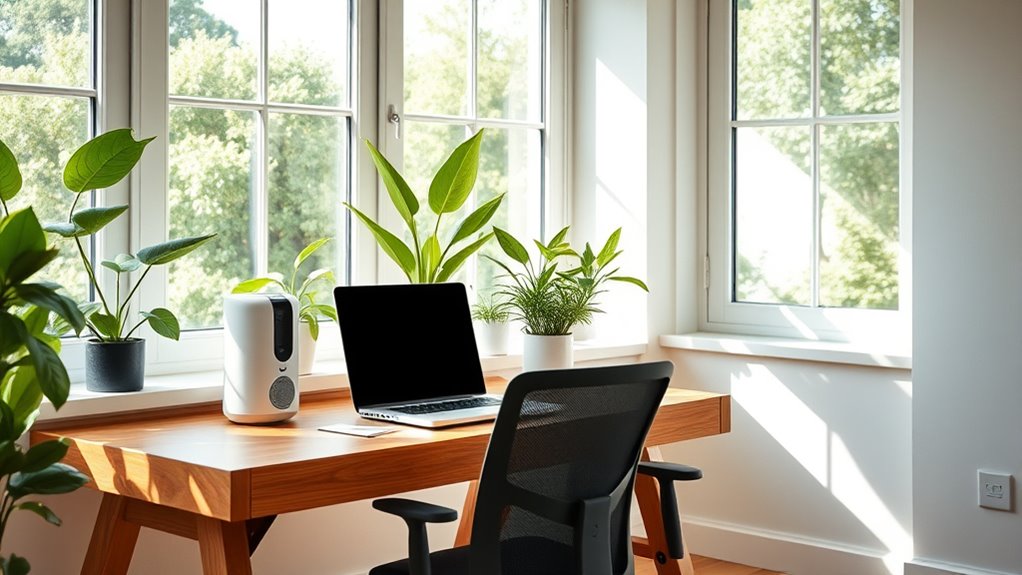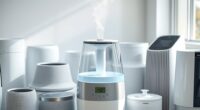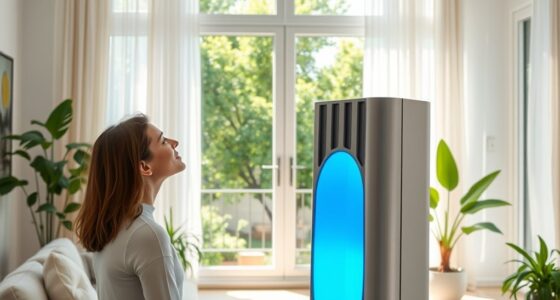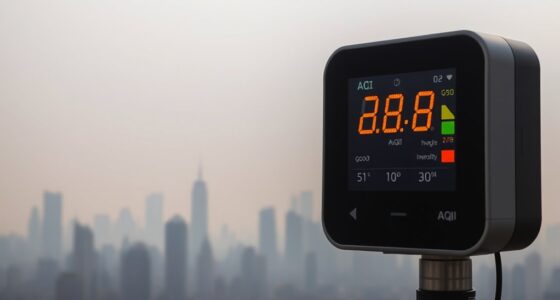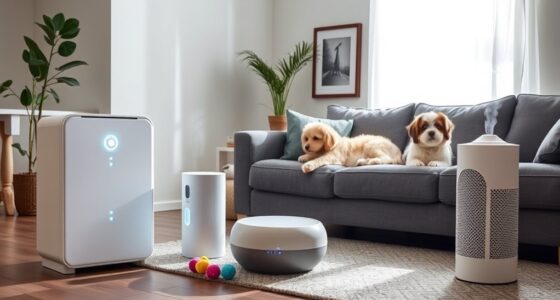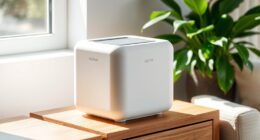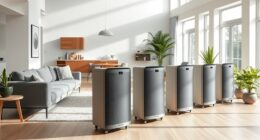To create a healthy home office, guarantee good air circulation by opening windows and using ventilation systems effectively. Use air purifiers with HEPA filters and add indoor plants like snake plants or peace lilies to naturally filter toxins. Minimize indoor pollutants by avoiding VOC-heavy products and keeping your space clean. Maintain humidity levels between 30-50% and regularly dust and clean surfaces. Stay mindful of these tips to enhance your workspace—there’s more to discover for better air quality.
Key Takeaways
- Ensure proper ventilation by opening windows and using exhaust fans to reduce indoor pollutant buildup.
- Use HEPA air purifiers and indoor plants like snake plants or peace lilies to filter toxins effectively.
- Minimize VOCs by choosing low-VOC furniture, paints, and avoiding artificial air fresheners.
- Maintain humidity levels between 30-50% with humidifiers or dehumidifiers to prevent mold and respiratory issues.
- Regularly clean surfaces and dust with microfiber cloths to reduce allergens and improve air quality.
Keep Your Space Well-Ventilated
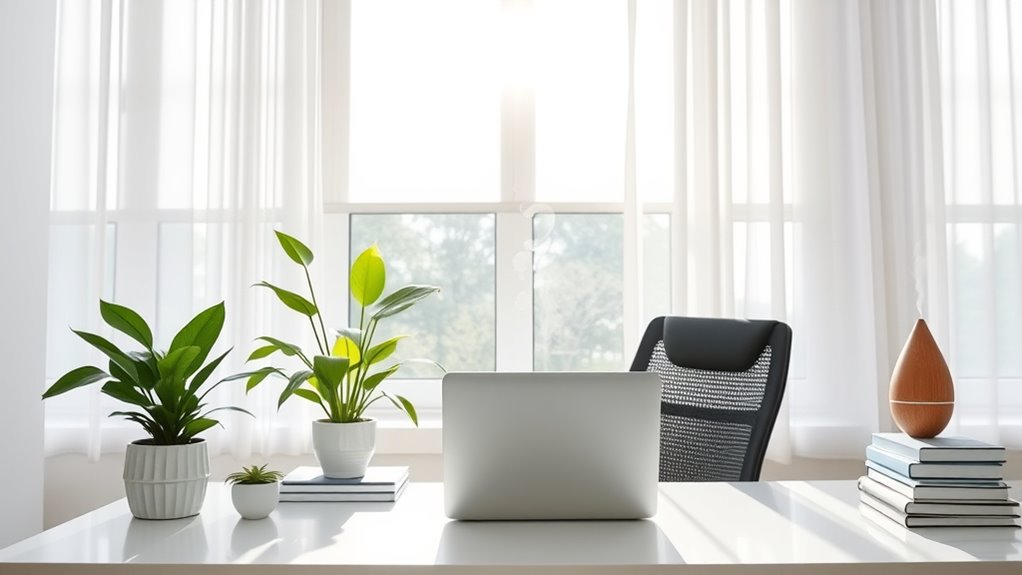
Keeping your home office well-ventilated is essential for maintaining a healthy environment. Good air circulation prevents the buildup of indoor pollutants and keeps fresh air flowing. Relying on ventilation systems, such as exhaust fans or HVAC filters, helps regulate airflow and remove stale air. If possible, open windows regularly to introduce natural ventilation, especially during pleasant weather. Ensure that your ventilation systems are clean and functioning properly to maximize their effectiveness. Proper air circulation not only improves air quality but also reduces the risk of mold and dust accumulation. Incorporating natural materials can further enhance indoor air quality by reducing volatile organic compounds and promoting a healthier workspace. By prioritizing ventilation, you create a workspace that supports your health and productivity, making it easier to focus and stay alert throughout your workday.
Use Air Purifiers and Plants

Using air purifiers and houseplants can substantially enhance your home office’s air quality. Air purifier benefits include removing pollutants, allergens, and dust particles, creating a cleaner environment that supports your focus and health. Choose models with HEPA filters for maximum effectiveness. Indoor plant choices like snake plants, pothos, or peace lilies are not only attractive but also naturally filter toxins from the air. These plants improve humidity levels and release oxygen, making your workspace more comfortable. Incorporating both air purifiers and plants provides a dual approach to reducing indoor pollutants and boosting air quality. Regularly maintain your devices and care for your plants to make sure they continue to contribute to a healthier, fresher home office environment. Additionally, selecting appropriate filtration technologies can further optimize air purification efforts for a healthier workspace.
Minimize Indoor Pollutants

To create a healthier home office, you need to actively minimize indoor pollutants that can compromise your air quality and wellbeing. Avoid air fresheners, which often release VOC emissions that can irritate your lungs and cause headaches. Instead, opt for natural alternatives like essential oils or simply open windows to refresh the air. Be mindful of cleaning products, paints, and furniture that emit volatile organic compounds, and choose low-VOC or VOC-free options whenever possible. Keep your workspace well-ventilated to reduce the buildup of indoor pollutants. Regularly clean surfaces to prevent dust and allergens from accumulating. Additionally, incorporating proper ventilation systems, such as heat pumps with advanced filtration, can significantly improve indoor air quality through improved air filtration. By reducing sources of VOC emissions and avoiding artificial scents, you create a safer, healthier environment that supports your productivity and overall health.
Maintain Optimal Humidity Levels
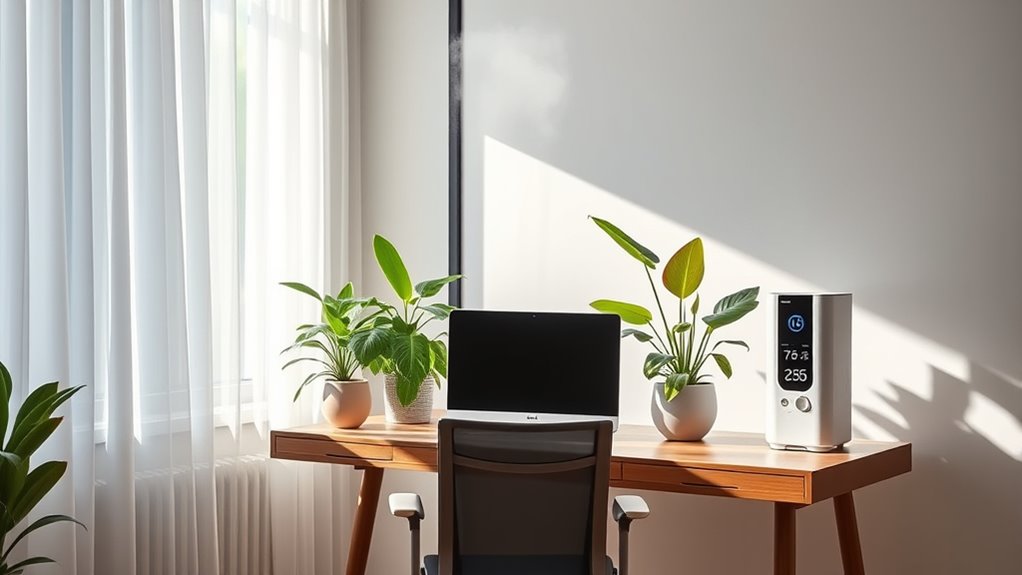
Maintaining the right humidity levels in your home office is essential for comfort and health. Aim for a humidity level between 30% and 50% to prevent dry skin, irritation, and respiratory issues. To achieve this, use a humidifier properly and ensure regular humidifier maintenance. Clean your device regularly to prevent mold and bacteria buildup, which can worsen air quality. Moisture control is key—if the air is too dry, add moisture; if it’s too humid, use a dehumidifier or increase ventilation. Keep an eye on humidity levels with a hygrometer, adjusting your humidifier as needed. Proper moisture regulation helps maintain a comfortable environment, reduces static electricity, and supports your respiratory health while working. Additionally, understanding air quality factors can help you create a healthier workspace environment.
Regularly Clean and Dust Your Office Area

Regular cleaning and dusting your office area is essential for maintaining a healthy workspace. Dust can settle on surfaces, including your ergonomic furniture, and trigger allergies or respiratory issues. Regularly wipe down desks, monitors, and shelves to reduce dust buildup. Proper cable management not only keeps your space tidy but also prevents dust from accumulating around cords and hidden areas. Use a microfiber cloth to dust surfaces and a vacuum with a HEPA filter to clean floors and carpets thoroughly. Keep clutter to a minimum to improve airflow and reduce dust traps. Maintaining a clean environment minimizes allergens and promotes better air quality, helping you stay focused and healthy during your workday. Understanding city dynamics is also crucial for creating a workspace that adapts well to your lifestyle and environment. Consistent cleaning is a simple step toward a safer, more comfortable home office.
Frequently Asked Questions
How Often Should I Replace or Clean My Air Purifier Filters?
You should check your air purifier’s filter maintenance schedule regularly, typically every 3 to 6 months. Replacing or cleaning filters more often might be necessary if you notice reduced airflow or odors. Proper filter maintenance helps extend your purifier’s lifespan and ensures it works efficiently. Keep an eye on the manufacturer’s recommendations, and don’t wait too long to replace filters, so your air stays clean and healthy.
What Are the Best Plants for Improving Indoor Air Quality?
Think of your home as a sanctuary, where greenery breathes life into your space. The best plants for improving indoor air quality include snake plants, pothos, and peace lilies—they’re easy to care for and serve as decorative plant options. With proper indoor plant care, these plants actively filter toxins and boost freshness, making your home office healthier and more inviting. Embrace these natural air purifiers to transform your workspace into a calming oasis.
How Can I Detect Poor Indoor Air Quality in My Home?
To detect poor indoor air quality, you can use air quality sensors that monitor pollutants, humidity, and VOC levels in real-time. Additionally, indoor air testing with professional kits helps identify hidden contaminants like mold, radon, or allergens. Pay attention to signs like musty odors, persistent allergies, or respiratory issues. Combining sensor data and testing results gives you a clear picture, allowing you to take necessary steps to improve your home’s air quality.
Are There Specific Cleaning Products Harmful to Air Quality?
Did you know that many conventional cleaning products release volatile organic compounds (VOCs), which can harm indoor air quality? You should avoid harmful cleaning products, especially those with strong fragrances or harsh chemicals. Instead, opt for eco-friendly cleaning and chemical-free products that are safer for your indoor environment. These choices help reduce pollutants, improve air quality, and keep your home healthier without sacrificing cleanliness.
How Does Pet Dander Affect Indoor Air in a Home Office?
Pet dander considerably impacts indoor air quality by increasing indoor allergens in your home office. When your pet sheds, dander particles float in the air, triggering allergies or respiratory issues. To improve air quality, you should regularly clean and vacuum, use HEPA air purifiers, and keep pets out of your workspace when possible. These steps help reduce pet dander and create a healthier environment for your work-from-home setup.
Conclusion
Creating a healthy home office isn’t just a task; it’s an investment in your well-being. Think of your space as a sanctuary where invigorating air and clean surfaces nurture your productivity and health. By implementing these simple tips, you’re not only improving air quality but also crafting an environment that inspires excellence. Remember, a breath of fresh air is the foundation of a thriving workspace—so breathe deep and make your home office a haven.
